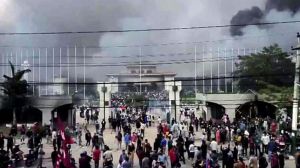33-year wait for justice: Punjab and Haryana High Court ends epic land feud
After a staggering 33 years, a 1992 appeal over a 1988 land sale is finally resolved, highlighting India’s glacial judicial pace.
 The court also found that Nand was no stranger to the transaction. Evidence showed he had acted as mediator.(File)
The court also found that Nand was no stranger to the transaction. Evidence showed he had acted as mediator.(File)In the fields of Nilianwali village, Sirsa, a 1988 farmland sale triggered a legal battle that spanned nearly four decades, outlasted the original litigants, and tested the patience of the Punjab and Haryana High Court. On Wednesday, Justice Deepak Gupta finally ended the feud, restoring a trial court ruling after a 33-year pendency of appeal.
The dispute began on May 25, 1988, when Surinder Pal Singh and others sold 73 kanal 7 marla of agricultural land to Darshan Singh for ₹1.51 lakh. Darshan, a farmer, said he was already cultivating the land on a one-third sharecrop basis, which protected the sale from challenge under Section 17-A of the Punjab Security of Land Tenure Act.
But Nand Singh, a co-sharer in the landholding, contested the deal. He filed a suit for pre-emption—a legal right that allows a co-sharer in agricultural land to step into the shoes of the buyer and purchase the property himself on the same terms, to prevent an outsider from entering the joint holding. Nand claimed Darshan was “a stranger to the khewat,” accusing him of inflating the price in the deed and manipulating crop inspection records. “He further alleged that the Khasra Girdawari entries for crop 1987 and Rabi 1988 showing possession of vendee defendant were manipulated to defeat his pre-emption rights,” the judgment records.
The trial court dismissed the suit in 1991, holding that Darshan’s tenancy was genuine and supported by revenue records. It observed: “The defendant was indeed in possession as a tenant on 1/3rd share batai; that corrections in the revenue record had been duly made after notice to the landowners in the presence of village officials.”
Nand appealed, and in 1992 the First Appellate Court reversed the verdict. It ruled that the sale deed contained “no recital of tenancy,” and disbelieved the April 1988 entry that showed Darshan’s possession. The court allowed Nand to pre-empt the land for ₹1.70 lakh.
Darshan challenged this decision in the High Court the same year. The appeal was admitted in July 1992 but languished for decades. Along the way, Nand died and his legal heirs pursued the case. Darshan faced separate forgery proceedings, which were later dropped, and partition orders were passed in 1992.
Finally, Justice Deepak Gupta delivered judgment this week. He held that pre-emption rights must exist on three dates, the sale in 1988, the suit filing in 1989, and the trial court ruling in 1991, and the land had not been partitioned by then. He also faulted the appellate court for rejecting official records: “In these circumstances, the First Appellate Court erred in disbelieving official records and Patwari’s testimony. The absence of reference to the defendant’s possession in the sale deed … does not outweigh the consistent and official revenue record.”
The court also found that Nand was no stranger to the transaction. Evidence showed he had acted as mediator: “Both the defendant and vendor testified that the sale was struck through Nand Singh’s intervention. This belies the plaintiff’s claim of ignorance about the transaction.”
Concluding that the sale was protected under Section 17-A, the High Court restored the 1991 trial court dismissal. “Accordingly, the judgment dated 22.04.1992 passed by the Additional District Judge, Sirsa is hereby set aside. The present appeal is allowed and the judgment & decree dated 10.06.1991 of the trial Court, dismissing the suit of Nand Singh, is restored.”







